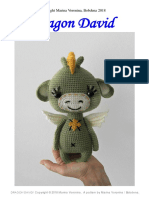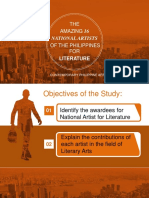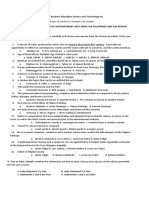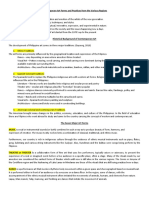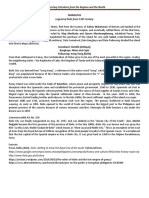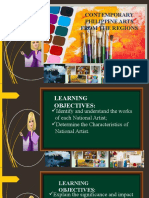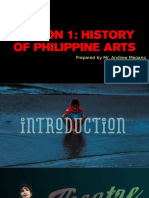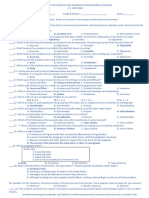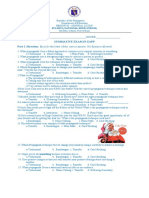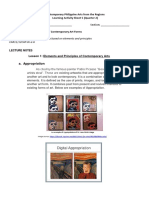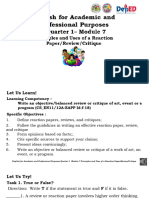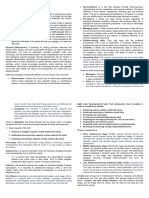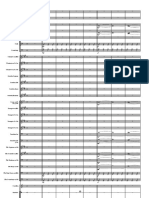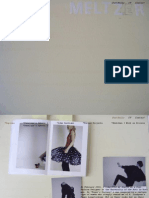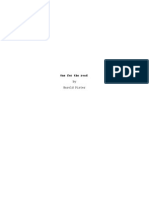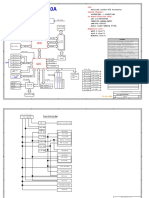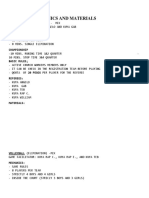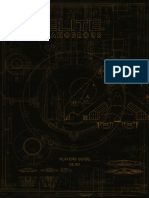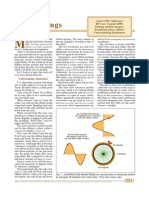0 ratings0% found this document useful (0 votes)
49 viewsConArts PPT Week1lesson 1
ConArts PPT Week1lesson 1
Uploaded by
Mary Alexes BejocContemporary Philippine arts have developed from three main traditions - the ethnic traditions of indigenous groups, the Spanish colonial tradition, and the American colonial and modern art traditions. Contemporary art in the Philippines draws from these influences and comments on cultural and political issues using various media like performance, painting, sculpture, and dance. Regional arts reflect the histories and cultures of different areas and contribute to the Philippines' rich cultural identity.
Copyright:
© All Rights Reserved
Available Formats
Download as PDF, TXT or read online from Scribd
ConArts PPT Week1lesson 1
ConArts PPT Week1lesson 1
Uploaded by
Mary Alexes Bejoc0 ratings0% found this document useful (0 votes)
49 views28 pagesContemporary Philippine arts have developed from three main traditions - the ethnic traditions of indigenous groups, the Spanish colonial tradition, and the American colonial and modern art traditions. Contemporary art in the Philippines draws from these influences and comments on cultural and political issues using various media like performance, painting, sculpture, and dance. Regional arts reflect the histories and cultures of different areas and contribute to the Philippines' rich cultural identity.
Original Title
ConArts-PPT-week1Lesson-1
Copyright
© © All Rights Reserved
Available Formats
PDF, TXT or read online from Scribd
Share this document
Did you find this document useful?
Is this content inappropriate?
Contemporary Philippine arts have developed from three main traditions - the ethnic traditions of indigenous groups, the Spanish colonial tradition, and the American colonial and modern art traditions. Contemporary art in the Philippines draws from these influences and comments on cultural and political issues using various media like performance, painting, sculpture, and dance. Regional arts reflect the histories and cultures of different areas and contribute to the Philippines' rich cultural identity.
Copyright:
© All Rights Reserved
Available Formats
Download as PDF, TXT or read online from Scribd
Download as pdf or txt
0 ratings0% found this document useful (0 votes)
49 views28 pagesConArts PPT Week1lesson 1
ConArts PPT Week1lesson 1
Uploaded by
Mary Alexes BejocContemporary Philippine arts have developed from three main traditions - the ethnic traditions of indigenous groups, the Spanish colonial tradition, and the American colonial and modern art traditions. Contemporary art in the Philippines draws from these influences and comments on cultural and political issues using various media like performance, painting, sculpture, and dance. Regional arts reflect the histories and cultures of different areas and contribute to the Philippines' rich cultural identity.
Copyright:
© All Rights Reserved
Available Formats
Download as PDF, TXT or read online from Scribd
Download as pdf or txt
You are on page 1of 28
CONTEMPORARY
PHILIPPINE ARTS FROM THE REGIONS
Contemporary Art Forms and
Their
Practices from the Various
Regions
Can you guess what form of Art is it????
• Arts play a significant role in the
abundant cultural identity of the
Philippines. It reflects the people, history,
and traditions of the Philippines as a
whole.
• With that, let us check your ideas about
Philippine arts.
INDIVIDUAL ACTIVITY
•Directions: Complete the graphic
organizer by supplying five words that
you think relates Philippine Arts.
Then, write three sentences that
explain why you think those words are
associated with the given main idea.
Write your answer on the answer sheet
provided.
Criteria 3 points 2 points 1 point No point
Relevance The learner The learner The learner presented The learner
presented presented original a general idea that was able to
original ideas ideas that explained explained only a present an
and explained 3 words from the specific word from the idea but not
all the words graphic organizer in graphic organizer. The related to any
in a well- a somewhat thought was organized of the words
organized and organized and and somewhat in the graphic
informative informative manner. informative. organizer.
manner.
Criteria 2 points 1 point No point
Conciseness The learner explained The learner explained The learner was not able
briefly his/her thought in briefly his/her thought to explain any of the
3 sentences without in less than three words written in the
grammatical error. sentences with few graphic organizer.
grammatical errors.
Lesson 1
Contemporary Art Forms in The Philippines
At the end of this lesson, you should be able to:
1. Defines Contemporary Art.
2. Identify the major contemporary art forms in the Philippines
3. Describes the contemporary art forms in the Philippines.
4. Describes their practices from the various regions,
5. Learners will broaden and acquire the necessary creative tools that open
opportunities in pursuing their individual career goals and aspiration.
What is Contemporary Arts?
▪ Art produced at the present period in time, includes and
develops from postmodern art, which is itself a
successor to Modern art.
▪ Art made and produced by artist living today.
▪ Statement that an artist makes about life, thoughts,
ideas, beliefs, and many other things that define human
life. Simultaneously reflects the realities and values of
our society.
Contemporary art is the art of today, produced by artists who
are living in the twenty-first century.
Contemporary art of the 21st century may combine
elements of performance, painting, sculpture, dance, and
many other media. It draws on the movements of modern art,
including minimalism and assemblage art, to create dynamic
pieces that aim to challenge the viewer and spark thought.
Many contemporary artists use their work to comment on
cultural and political issues, including race, human rights,
economic inequality, and global conflict.
TIMELINE OF PHILIPPINE ARTS
The development of the Philippine arts comes in three
major traditions. These are the Ethnic Tradition,
Spanish Colonial Tradition, and American Colonial and
Contemporary Arts Traditions. Even before the
colonization, the Philippines already has its indigenous
arts. In this era, art forms were primarily influenced by
the area where our ancestors prosper.
ETHNIC TRADITION/ ETHNIC ART
AND ISLAMIC ART
Manunggul Jar
Manunggul jar is found in
Manunggul Cave, Lipuun
Point, Palawan in the early
1960s.
Manunggul jar is a burial jar
which signifies the belief of
early Filipino in life after
death.
Banga
Banga literally means pots.
The Banga or pot dance is a
performance of Kalinga of the
Mountain Province of the
Philippines. This dance
shows the elegant grace of
Igorot tribe and the skill and
strength of women.
Angono Petroglyphs The Angono Petroglyphs is
situated in Binangonan,
Rizal. It was discovered by the
National Artist, Carlos “B g” , 1
There are 127 human and animal figures engraved on
the rock wall and dated back
g to circa late Neolithic.
g g 1 g
However, the Spaniards came who tend to
replace indigenous arts with western arts.
For the period of Spanish rule, art forms
were primarily influenced by religion and
secularization. Consequently, after more
than three centuries of Spanish
colonization.
SPANISH TRADITION/ SPANISH ERA
St. Paul Metropolitan Cathedral
St. Paul Metropolitan Cathedral is
located in Burgos, Vigan City,
Ilocos Sur. The original structure
was built in 1574 and replaced as a
church in 1641. The cathedral
follows a Baroque architectural
design.
•Langit, lupa, at Impyerno by Josef
Luciano Dans
•This wall painting by Josef Luciano Dans will
be found in St. James the Apostle Church in
Paete, Laguna. This painting was dated 1850
and depicts the heaven, crucifixion of Christ;
earth, Adan and Eve; and hell, sinners with
different transgressions.
• Americans came. During American
rule, development of Philippine art
forms was mainly influenced by
education and governance.
Subsequently, concept of modern art
was introduced and practiced by
many artists.
AMERICAN TRADITION/ SECULAR
FORM OF ART, MODERN ART
The Making of the Philippine
Flag
by Fernando Amorsolo
This painting was made by
Fernando Amorsolo, “Grand Old
Man of Philippine Art” and born
in Manila. It shows a reminder of
the reminder of traditions and
customs of the Filipino.
Bayanihan
by C r s “B g” Fr c sc C “B g”
born in Ango, Rizal. This painting by him was dated in
1962. This mural painting of C “B g”
1 11 ’ bayanihan tradition. This also shows
the distinctive style of Fran ’ g ed
his mastery in arts.
It is in this time wherein urbanization, consumerism,
changes in the political system, and rise of new
technology influence the development of art. Due to
the technological advances, new forms of
expression came in the field of arts and modern art
continuously developed which led to the
contemporary arts nowadays .
These art forms from various regions or from various
artists contributed to the picture of Philippine’s identity as
a country. And as a Filipino, it’s important that we have
knowledge to describe these art forms based on its details
and elements, in relation to our country’s culture and
tradition, that makes it an artistic piece. In the field of arts,
knowing the elements and principles of arts is important,
not just to the artist but also to the viewer, to have a
deeper understanding of an artwork. Now, let us know
these elements and principles of arts.
You might also like
- Dragon DavidDocument16 pagesDragon DavidBup Be Bac94% (16)
- IFA Coaching Session PlannerDocument2 pagesIFA Coaching Session Plannerabdesslam chamamiNo ratings yet
- English For Academic and Professional PurposesDocument10 pagesEnglish For Academic and Professional PurposesJoshua De los Santos100% (1)
- Level 1 Workbook Answer Key: Reading Plus 1 (Page 80)Document4 pagesLevel 1 Workbook Answer Key: Reading Plus 1 (Page 80)Юлия ЗубовскаяNo ratings yet
- National Artists of The Philippines PDFDocument53 pagesNational Artists of The Philippines PDFJamila Mesha Ordo�ez100% (1)
- Burgos ST, District II, Cauayan City IsabelaDocument3 pagesBurgos ST, District II, Cauayan City IsabelaJanet PaggaoNo ratings yet
- G11 - Oral CommunicationDocument7 pagesG11 - Oral Communicationjamesmarken100% (1)
- Copy-of-CPAR Q1 Mod7Document18 pagesCopy-of-CPAR Q1 Mod7jhudel cabbatNo ratings yet
- Q4 Applied Eapp WK5Document4 pagesQ4 Applied Eapp WK5Jomarie LagosNo ratings yet
- Creative Industries 1 Module 4Document17 pagesCreative Industries 1 Module 4Jane ManaliliNo ratings yet
- Eapp q3 Week4 THESISDocument31 pagesEapp q3 Week4 THESISEVA MAE BONGHANOY100% (1)
- Practical Research 1 - Quarter 1 - Module 3 of 4 - Identifying The Inquiry and Stating The Probem (Week 5 To Week 6) - v2Document13 pagesPractical Research 1 - Quarter 1 - Module 3 of 4 - Identifying The Inquiry and Stating The Probem (Week 5 To Week 6) - v2loraine.ruadoNo ratings yet
- Formative Test ContempDocument3 pagesFormative Test ContempAliyah PlaceNo ratings yet
- Contemporary Philippine Arts From The Regions: Quarter 1Document10 pagesContemporary Philippine Arts From The Regions: Quarter 1JUN GERONANo ratings yet
- CPAR - Lesson 4Document14 pagesCPAR - Lesson 4Ryan EstonioNo ratings yet
- Philippine Contemporary ArtsDocument12 pagesPhilippine Contemporary ArtsAlyzee GeronNo ratings yet
- Contemporary Philippine Art First Quarter Exam ReviewerDocument9 pagesContemporary Philippine Art First Quarter Exam ReviewerNicole AspirasNo ratings yet
- Activity Sheets in Entrepreneurship 12 Quarter 1, Week 1-2: Discuss The Relevance of The CourseDocument11 pagesActivity Sheets in Entrepreneurship 12 Quarter 1, Week 1-2: Discuss The Relevance of The CourseJacques Amber RiegoNo ratings yet
- Bigsaywit NarrativeDocument4 pagesBigsaywit Narrativejein_amNo ratings yet
- In An Ocean of Emotions Philippine DramaDocument21 pagesIn An Ocean of Emotions Philippine DramaAlyson CarandangNo ratings yet
- PR1 Week 8Document38 pagesPR1 Week 8Jessa LuansingNo ratings yet
- National ArtistDocument25 pagesNational Artistkristine molenillaNo ratings yet
- National Artists For Dance Music FilmDocument36 pagesNational Artists For Dance Music FilmPurh Bii DhahNo ratings yet
- Origin of Iloilo - Hiligaynon Epics NotesDocument7 pagesOrigin of Iloilo - Hiligaynon Epics NotesRojem Mae del CarmenNo ratings yet
- Quarter 3 Module 5Document47 pagesQuarter 3 Module 5Ashlie AbalaNo ratings yet
- SLK - Contemporary Art 12 - Q1 - LC2Document30 pagesSLK - Contemporary Art 12 - Q1 - LC2SHEEN ALUBANo ratings yet
- CPAR - 1st Periodical Exam SY 22-23Document3 pagesCPAR - 1st Periodical Exam SY 22-23Myline SisalboNo ratings yet
- G12 Applied Practical Research 3 Apr27-30Document3 pagesG12 Applied Practical Research 3 Apr27-30Angel PanganNo ratings yet
- Attendance Sheet: Division of Agusan Del SurDocument3 pagesAttendance Sheet: Division of Agusan Del SurJESSELLY VALESNo ratings yet
- Englishforacademic - Quarter 1 Module 1Document27 pagesEnglishforacademic - Quarter 1 Module 1Stephanie AriasNo ratings yet
- Interactive Learning Materials Chapter 1-4 2023Document45 pagesInteractive Learning Materials Chapter 1-4 2023Michelle BautistaNo ratings yet
- Expository Persuasive EntertainmentDocument4 pagesExpository Persuasive EntertainmentMICHAEL STEPHEN GRACIASNo ratings yet
- Chapter 1 Nature of Inquiry and ResearchDocument2 pagesChapter 1 Nature of Inquiry and ResearchCelyn Gahol100% (4)
- Plant and Animal ReproductionDocument7 pagesPlant and Animal Reproductionstephruth constantinoNo ratings yet
- National Artist in The Phil.Document63 pagesNational Artist in The Phil.Gail SalazarNo ratings yet
- Cpar Week-3Document24 pagesCpar Week-3Dulce M. LupaseNo ratings yet
- Contemporary Arts in The PhilippinesDocument86 pagesContemporary Arts in The PhilippinesjhomalynNo ratings yet
- MAPEH 10 Lesson 1 and 2 20th Century Traditional ComposersDocument10 pagesMAPEH 10 Lesson 1 and 2 20th Century Traditional ComposersNielbienGamingYTNo ratings yet
- Writing A Reaction Paper, Review and CritiqueDocument11 pagesWriting A Reaction Paper, Review and CritiqueDominica T. AdoracionNo ratings yet
- Academic Text Structure and Three Part Essay Structure GAP FILLING ACTIVITYDocument2 pagesAcademic Text Structure and Three Part Essay Structure GAP FILLING ACTIVITYRlly JayNo ratings yet
- Mixed Media ArtDocument19 pagesMixed Media ArtIan SumastreNo ratings yet
- Chapter 2 ExposureDocument27 pagesChapter 2 Exposureallanrnmanaloto100% (1)
- History of Philippine Art TheatreDocument76 pagesHistory of Philippine Art TheatreNats Magbalon0% (1)
- Lesson 2-Contemporary Art Forms, Techniques and Performance PracticesDocument74 pagesLesson 2-Contemporary Art Forms, Techniques and Performance Practicesgerome tagalanNo ratings yet
- Diagnostic Test EappDocument2 pagesDiagnostic Test EappEloisa Rei BeloroNo ratings yet
- Practicum Exercise Field Report: March 2018Document25 pagesPracticum Exercise Field Report: March 2018SHOLANKE EZEKIEL SHOWUNMINo ratings yet
- Personal Development 1Document22 pagesPersonal Development 1Gladzangel LoricabvNo ratings yet
- Eapp - Week-9 - Quarter-1-2023-2024Document5 pagesEapp - Week-9 - Quarter-1-2023-2024MaricelNo ratings yet
- Guidelines in JournalismDocument46 pagesGuidelines in Journalismmaverick embalsadoNo ratings yet
- Final ExamDocument3 pagesFinal ExamLonlon VictorioNo ratings yet
- Activity 3Document3 pagesActivity 3Rajah Jimena VillamilNo ratings yet
- Eapp ReviewerDocument4 pagesEapp ReviewerKristine SaleNo ratings yet
- Eapp Survey ReportDocument43 pagesEapp Survey Reportylaizagrace17No ratings yet
- Day 3.2 READING TEXTBOOKS IN MATHEMATICS AND HUMANITIES (Autosaved)Document30 pagesDay 3.2 READING TEXTBOOKS IN MATHEMATICS AND HUMANITIES (Autosaved)Christine Anne ClementeNo ratings yet
- 3 Q2-ConartsDocument28 pages3 Q2-ConartsKlyn AgananNo ratings yet
- TechVoc Education © 2017Document23 pagesTechVoc Education © 2017Amir M. VillasNo ratings yet
- Writing A LaboratoryDocument18 pagesWriting A LaboratoryheeueuNo ratings yet
- Writing The RRLDocument15 pagesWriting The RRLIanne FabianNo ratings yet
- Contemporary Philippine Arts From The Regions Learning Activity Sheet 5 (Quarter 2)Document11 pagesContemporary Philippine Arts From The Regions Learning Activity Sheet 5 (Quarter 2)구독봉이No ratings yet
- Tests of Grammar and Usage: Muhammad Aldin Ramadhan 2018310001Document13 pagesTests of Grammar and Usage: Muhammad Aldin Ramadhan 2018310001Muhammad AldinNo ratings yet
- Schools Division of Zamboanga Del Norte Ubay National High School Labason Ii DistrictDocument4 pagesSchools Division of Zamboanga Del Norte Ubay National High School Labason Ii DistrictAndevie Balili Iguana100% (1)
- Eapp - Q1 - Module 7Document54 pagesEapp - Q1 - Module 7leighkrisnae.gatchoNo ratings yet
- Personal Development Quarter 2 Week 5Document33 pagesPersonal Development Quarter 2 Week 5Mary Alexes BejocNo ratings yet
- Personal Development FinishedDocument8 pagesPersonal Development FinishedMary Alexes BejocNo ratings yet
- EAPP Q1 FinishedDocument7 pagesEAPP Q1 FinishedMary Alexes BejocNo ratings yet
- Contemporary Art Forms From Week 3Document50 pagesContemporary Art Forms From Week 3Mary Alexes BejocNo ratings yet
- Libertango para Orquesta ReducidaDocument14 pagesLibertango para Orquesta ReducidaÁlvaro AlmadaNo ratings yet
- Potato ChipsDocument1 pagePotato ChipsRader YTMNo ratings yet
- Cwcheat DB TXT ExportDocument3,864 pagesCwcheat DB TXT Exportabdullatif ferdiansyahNo ratings yet
- Double Wall TankDocument1 pageDouble Wall TankFerry Triyana AnirunNo ratings yet
- Jonsered Ict H 16Document84 pagesJonsered Ict H 16Salif SaidNo ratings yet
- Fashion Designer: Lena MeltzerDocument37 pagesFashion Designer: Lena MeltzerNedra Dadou100% (1)
- Manual Standalone: Installation and Authorization File MenuDocument7 pagesManual Standalone: Installation and Authorization File MenuthetarlabNo ratings yet
- Magical Explorer Vol 1Document232 pagesMagical Explorer Vol 1techmanOP amv'sNo ratings yet
- Harold Pinter - One For The RoadDocument18 pagesHarold Pinter - One For The RoadNicolás Palma Cornejo100% (1)
- MS 6701Document28 pagesMS 6701Дима КальмовNo ratings yet
- INFO - by Doctor+ ProductionsDocument6 pagesINFO - by Doctor+ ProductionsSocol IrinaNo ratings yet
- Unit 1 Higher Test: VocabularyDocument5 pagesUnit 1 Higher Test: VocabularysoulalmaNo ratings yet
- 010-7110a SisdDocument4 pages010-7110a SisdRaimundo JúniorNo ratings yet
- Mechanics and Materials: Basketballl (Elimination) - MixDocument10 pagesMechanics and Materials: Basketballl (Elimination) - MixRonald PascualNo ratings yet
- Germicidal Action of MilkDocument9 pagesGermicidal Action of MilkMohammad Ashraf PaulNo ratings yet
- English PlayersGuide v2.4Document105 pagesEnglish PlayersGuide v2.4Robert WilburNo ratings yet
- DLD 5500 LNWDocument4 pagesDLD 5500 LNWManu MathewNo ratings yet
- Lady Aurelei Gavrayn: Ranger 1 Noble Half-Elf Chaotic GoodDocument3 pagesLady Aurelei Gavrayn: Ranger 1 Noble Half-Elf Chaotic GoodMarcello LarcherNo ratings yet
- Bartok in His Own MusicDocument13 pagesBartok in His Own MusicDaniel Perez100% (1)
- CatalogDocument36 pagesCatalogsumit palNo ratings yet
- Strangities - The More Mundane Adventures of Blue Stahli (Ep 01)Document13 pagesStrangities - The More Mundane Adventures of Blue Stahli (Ep 01)AishaGrewalNo ratings yet
- Set A Light 3d Handbuch v1.10 enDocument70 pagesSet A Light 3d Handbuch v1.10 enmriganka sekhar surNo ratings yet
- Liverpool 2019Document21 pagesLiverpool 2019Diego VazquezNo ratings yet
- Ft450 ManualDocument104 pagesFt450 ManualAlexandreNo ratings yet
- January 2019 Tennis IndustryDocument72 pagesJanuary 2019 Tennis IndustryLiya Davidov100% (2)
- Understanding QuadratureDocument6 pagesUnderstanding Quadraturekunduru_reddy_3No ratings yet
